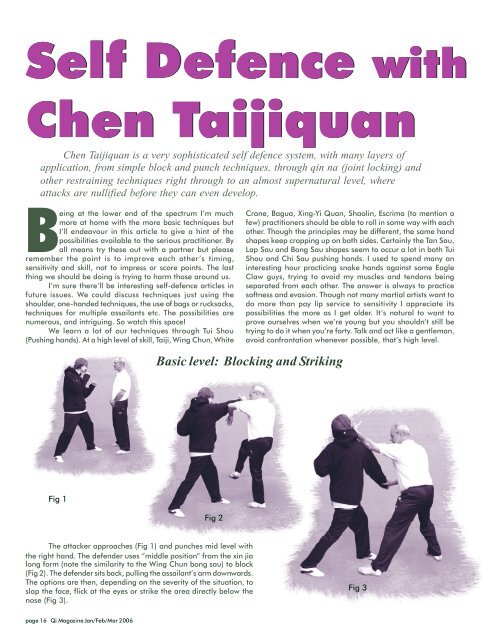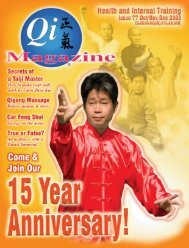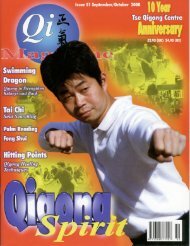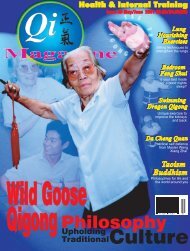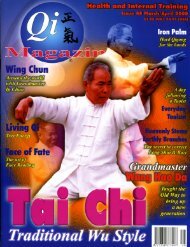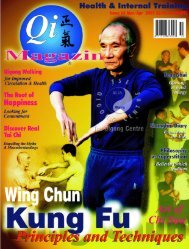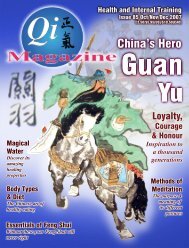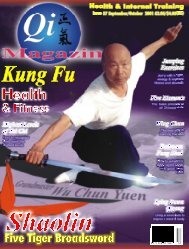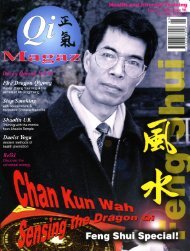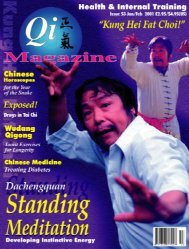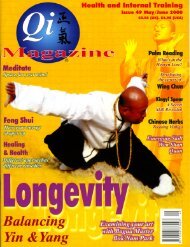Issue 78 - Tse Qigong Centre
Issue 78 - Tse Qigong Centre
Issue 78 - Tse Qigong Centre
- TAGS
- issue
- qigong
- qimagazine.com
You also want an ePaper? Increase the reach of your titles
YUMPU automatically turns print PDFs into web optimized ePapers that Google loves.
Self Defence with<br />
Chen Taijiquan<br />
Chen Taijiquan is a very sophisticated self defence system, with many layers of<br />
application, from simple block and punch techniques, through qin na (joint locking) and<br />
other restraining techniques right through to an almost supernatural level, where<br />
attacks are nullified before they can even develop.<br />
Being at the lower end of the spectrum I’m much<br />
more at home with the more basic techniques but<br />
I’ll endeavour in this article to give a hint of the<br />
possibilities available to the serious practitioner. By<br />
all means try these out with a partner but please<br />
remember the point is to improve each other’s timing,<br />
sensitivity and skill, not to impress or score points. The last<br />
thing we should be doing is trying to harm those around us.<br />
I’m sure there’ll be interesting self-defence articles in<br />
future issues. We could discuss techniques just using the<br />
shoulder, one-handed techniques, the use of bags or rucksacks,<br />
techniques for multiple assailants etc. The possibilities are<br />
numerous, and intriguing. So watch this space!<br />
We learn a lot of our techniques through Tui Shou<br />
(Pushing hands). At a high level of skill, Taiji, Wing Chun, White<br />
Fig 1<br />
Basic level: Blocking and Striking<br />
The attacker approaches (Fig 1) and punches mid level with<br />
the right hand. The defender uses “middle position” from the xin jia<br />
long form (note the similarity to the Wing Chun bong sau) to block<br />
(Fig 2). The defender sits back, pulling the assailant’s arm downwards.<br />
The options are then, depending on the severity of the situation, to<br />
slap the face, flick at the eyes or strike the area directly below the<br />
nose (Fig 3).<br />
page 16 Qi Magazine Jan/Feb/Mar 2006<br />
Fig 2<br />
Crane, Bagua, Xing-Yi Quan, Shaolin, Escrima (to mention a<br />
few) practitioners should be able to roll in some way with each<br />
other. Though the principles may be different, the same hand<br />
shapes keep cropping up on both sides. Certainly the Tan Sau,<br />
Lap Sau and Bong Sau shapes seem to occur a lot in both Tui<br />
Shou and Chi Sau pushing hands. I used to spend many an<br />
interesting hour practicing snake hands against some Eagle<br />
Claw guys, trying to avoid my muscles and tendons being<br />
separated from each other. The answer is always to practice<br />
softness and evasion. Though not many martial artists want to<br />
do more than pay lip service to sensitivity I appreciate its<br />
possibilities the more as I get older. It’s natural to want to<br />
prove ourselves when we’re young but you shouldn’t still be<br />
trying to do it when you’re forty. Talk and act like a gentleman,<br />
avoid confrontation whenever possible, that’s high level.<br />
Fig 3


